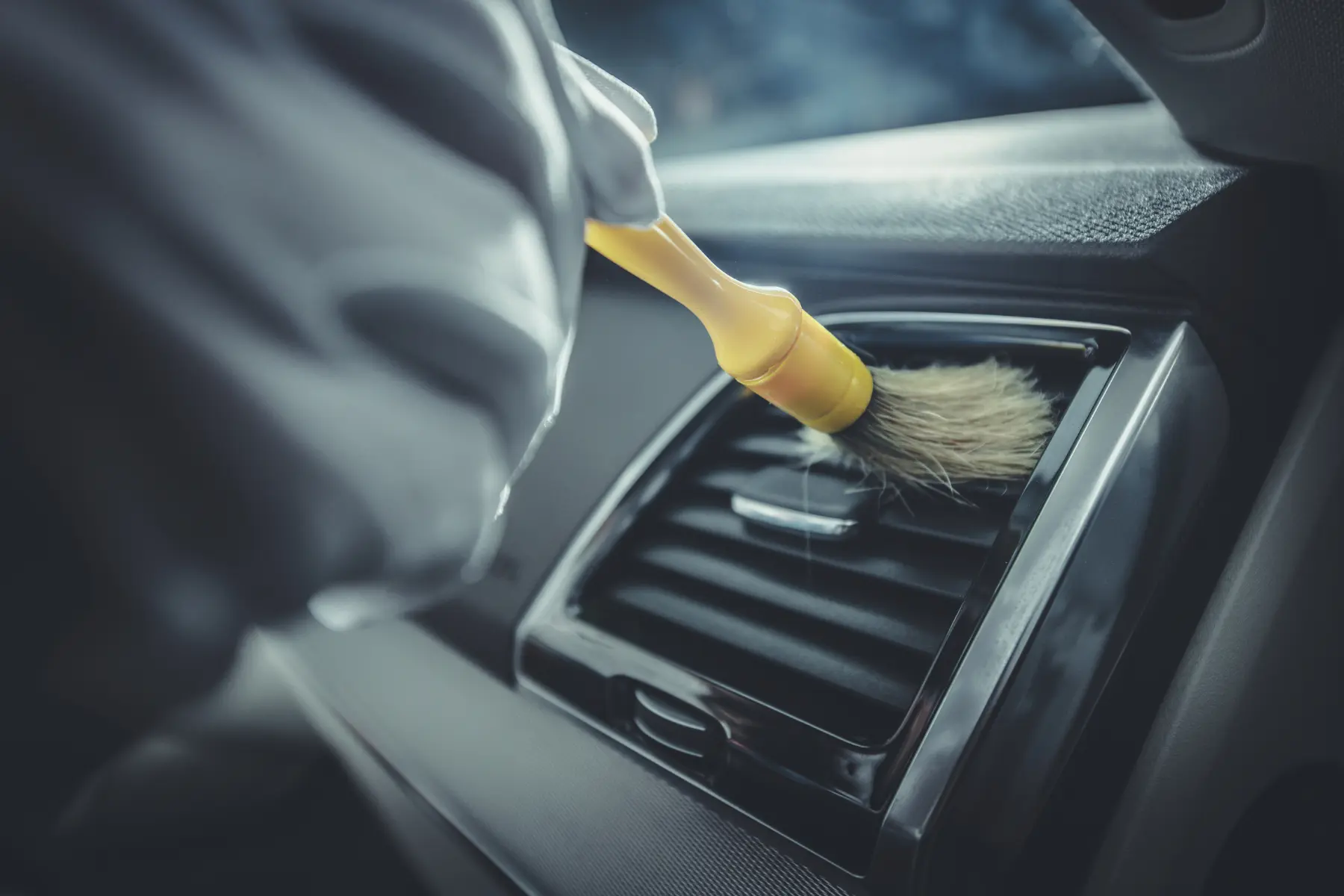About JC Whitney Editorial Team

Meet the JC Whitney Editorial Team, your go-to experts for automotive insights, from in-depth car culture articles to the latest in vehicle tech.
More from JC Whitney Editorial TeamCar detailing is more than just a thorough washing of your vehicle; it’s an intricate process designed to make your car look as close to new as possible. This involves deep cleaning both the interior and exterior, polishing, waxing, and applying protectants to various surfaces. Auto detailing basics cover everything from removing contaminants from the paintwork to vacuuming every nook and cranny of the interior. It’s a labor of love that not only improves the appearance of your car but can also protect and extend the life of its materials, including paint, upholstery, and wheels.
Auto Detailing Basics
Overview of Essential Detailing Steps
The journey begins with a thorough wash to remove dirt and grime, followed by clay bar application to eliminate surface contaminants. Next, polishing removes minor scratches and swirls, enhancing the paint’s shine. Car exterior waxing seals the deal, providing a protective layer against the elements. Interior detailing involves vacuuming, steam cleaning, and conditioning of upholstery and surfaces to breathe new life into the car’s cabin.
Tools and Products for Effective Detailing
The effectiveness of your detailing endeavor heavily relies on the tools and best car detailing products you use. Essential tools include a high-quality car wash soap, microfiber cloths, a clay bar, polish, wax, and a reliable vacuum cleaner for the interior. Specialized products, such as leather conditioner and tire shine, further enhance the detailing process. Investing in quality products ensures not only a more efficient detailing process but also superior protection and longevity for your vehicle.
Establishing a Detailing Routine for Long-Term Care
Maintaining your vehicle’s showroom shine requires more than a one-time effort; it demands a consistent detailing routine. Regularly scheduled detailing sessions prevent the accumulation of dirt and damage from environmental exposure. Integrating DIY car detailing into your routine can be both satisfying and cost-effective, while occasional professional car detailing services ensure no detail is overlooked.
Car Interior Detailing
Car Upholstery Cleaning
This process involves vacuuming, spot treatment with appropriate cleaners, and thorough scrubbing or steam cleaning for deeper stains. For fabric upholstery, using a fabric cleaner and a soft brush can lift dirt and spills. Leather upholstery requires special care with a leather cleaner and conditioner to keep it soft and prevent cracking.
Detailing Dashboard and Interior Surfaces
The dashboard and other interior surfaces accumulate dust and can suffer from UV damage over time. Cleaning these areas involves dusting with a microfiber cloth, applying a mild cleaner, and using protectants to shield surfaces from the sun’s harmful rays. Attention to detail, such as cleaning vents with a soft brush and treating leather components with leather care techniques, ensures every part of the interior looks and feels fresh.
Techniques for Carpet and Mat Cleaning
Maintaining the cleanliness of your car’s carpets and mats is essential for preserving the interior’s appearance and hygiene. Over time, these areas accumulate dirt, stains, and odors that can detract from your vehicle’s comfort and aesthetic appeal. Here is a guide to effectively clean your car’s carpets and mats, ensuring they remain in top condition:
- Vacuum Thoroughly: Start by removing all mats from the car. Use a vacuum cleaner to remove loose dirt and debris from the interior carpet and the mats. It’s important to vacuum every nook and cranny, as dirt can easily become embedded in the fibers of the carpet and mats, leading to wear over time.
- Apply Carpet Cleaner: Select a carpet cleaner that is specifically designed for automotive use, ensuring it’s suitable for the type of carpet and mat material in your car. Apply the cleaner according to the instructions on the product label. This step is crucial for addressing tough stains and ground-in dirt that vacuuming alone cannot remove.
- Agitate with a Brush: Use a soft-bristled brush to gently agitate the cleaner on the carpet and mats. Pay special attention to stained areas, using the brush to break up the dirt.
- Blot and Vacuum: After scrubbing, blot the treated areas with a microfiber towel to absorb the cleaner and the lifted dirt. For deeper cleaning, consider using a wet-dry vacuum to suck up any excess moisture and residue. This step helps ensure that no cleaning solution remains in the carpet, which could attract more dirt over time.
- Air Dry Completely: Allow the carpets and mats to air dry thoroughly before placing them back in the car. Drying is a critical step to prevent the growth of mold and mildew, which can cause unpleasant odors and potential health issues. If possible, leave the mats in a sunny, well-ventilated area to speed up the drying process.
By following these steps, you can effectively clean your car’s carpets and mats, removing dirt, stains, and odors. This process not only improves the visual appeal of your car’s interior but also contributes to a healthier and more pleasant driving environment.
Exterior Detailing and Paint Care
Vehicle Paint Correction
How to polish car surfaces is another essential aspect of maintaining its aesthetic appeal. Polishing differs from waxing as it involves using a product that contains abrasives to remove a fine layer of the paint surface. This step is crucial for removing small scratches, swirls, and other imperfections, leading to a flawless finish. Polishing should be done before waxing to prepare the surface and enhance the wax’s protective and shiny properties. Select a polish based on your car’s needs; some are designed for heavy correction, while others are for light enhancement. Use a dual-action polisher or a hand applicator pad for application, depending on your comfort and experience level.
Regular Washing Practices for Exterior Maintenance
Regular washing of your car’s exterior is essential to maintaining it’s aesthetic and shielding its surface from the weather. Dirt, pollutants, and bird droppings can cause long-term damage to the paint if not regularly cleaned off. Here are some detailed strategies for effective exterior maintenance:
- Choose the Right Time and Place: Always wash your car in the shade or on a cloudy day to prevent the sun from drying the soap too quickly. Sunlight can cause water and soap to evaporate before you have a chance to rinse them off, leaving spots and streaks on the paint.
- Select Appropriate Cleaning Agents: It’s vital to use cleaning agents specifically designed for cars. These soaps are formulated to clean effectively without damaging the paint or stripping away protective wax. Household detergents, on the other hand, can be too harsh for automotive paint, leading to dullness or damage over time.
- Employ the Two-Bucket Method: Utilize one bucket for clean, soapy water and another for rinsing your wash mitt or sponge. This technique helps prevent the transfer of dirt and debris back onto the car’s surface, minimizing the risk of scratching the paint. It’s a simple but effective way to ensure a scratch-free and thorough wash.
- Gentle Washing Techniques: Using a soft wash mitt or sponge, wash the car from top to bottom in gentle, circular motions. Starting from the top ensures that dirt and soap don’t run down onto already-cleaned surfaces. Applying too much pressure can embed debris into the paint and cause scratches, so it’s important to be gentle throughout the process.
- Rinse Thoroughly: After washing, rinse the car thoroughly with clean water to remove all traces of soap. Leaving soap on the car can cause residue buildup or streaking once the car dries. A thorough rinse helps ensure a spotless and streak-free finish.
- Dry Properly: Drying the car with microfiber towels helps prevent water spots and reduces the risk of scratching the paint. Microfiber towels are highly absorbent and soft, making them ideal for drying the car’s surface without causing damage. Avoid using materials like old rags or bath towels.
Following these steps for regular car washing not only keeps your vehicle looking its best but also protects its surface from damage. Regular washing is an easy and effective way to maintain the car’s exterior, ensuring it remains in good condition for years to come.
Specialized Detailing Areas
Headlight Restoration for Improved Visibility
ver time, headlights can become yellowed and cloudy due to oxidation, significantly reducing the effectiveness of your headlights and, consequently, your visibility at night. Headlight restoration tips include starting with a thorough cleaning and then moving on to sanding the headlight covers with increasingly fine sandpaper to remove oxidation. After sanding, applying a polishing compound helps restore the clear look. Finally, sealing the headlights with a UV-resistant sealant prevents future oxidation. This process not only improves the appearance of your vehicle but also enhances your night-time driving safety by ensuring your headlights are as bright as possible.
Engine Bay Cleaning
When undertaking engine bay cleaning, ensure the engine is cool and cover any sensitive components like the alternator and air intake with plastic. Use a degreaser to spray down the engine bay, then gently scrub with a brush to remove grime and oil buildup. Rinsing should be done carefully, preferably with low-pressure water, to avoid damaging any electrical components. Drying the area thoroughly with microfiber towels or a blower can prevent water spots and corrosion.
Wheel and Tire Detailing for a Complete Look
Wheels and tires significantly impact the overall appearance of your car. Start by using a quality wheel cleaner to remove brake dust and road grime, ensuring it’s suitable for your type of wheels to avoid damage. For tires, applying a tire cleaner before scrubbing them down removes buildup and prepares them for a tire dressing, which should be applied last to give a fresh, clean look.
DIY vs. Professional Detailing
Comparing Costs: DIY vs. Professional
As mentioned previously, cost is a significant factor when deciding between DIY and professional detailing. Initially, setting up for DIY car detailing involves purchasing the best car detailing products, tools, and materials, which can add up. However, once you have these items, the cost per detail decreases significantly, making it a more economical choice in the long run for those who detail regularly. On the other hand, professional detailing services offer the advantage of expertise and specialized equipment but at a higher price point per session. The choice between DIY and professional detailing will depend on your budget, how much you value your time, and the level of detailing required to meet your standards.
Mobile Detailing Guide
These offer a convenient solution by bringing the detailing to your doorstep, eliminating the need to drive to a detailing shop and wait for your vehicle to be serviced. This convenience is especially beneficial for those with busy schedules or limited access to professional detailing locations. Mobile detailers can provide a range of services from basic washes and interior cleaning to more comprehensive packages including waxing and polishing. However, the downside might include higher costs due to the convenience and potential limitations on the range of services offered compared to a stationary detailing shop.
As automotive technologies and materials evolve, so too should your detailing practices. Staying informed about the latest products, tools, and techniques is crucial for adapting to new challenges and ensuring your detailing efforts are as effective as possible. Embrace innovations in the detailing world, such as ceramic coatings and eco-friendly products, that offer enhanced protection and sustainability. Additionally, consider the benefits of learning from professionals through workshops or online tutorials to refine your skills. The journey to maintaining a showroom shine is ongoing, with each detailing session offering an opportunity to learn and improve. By remaining curious and dedicated, you can ensure your vehicle not only shines but also stands the test of time.
